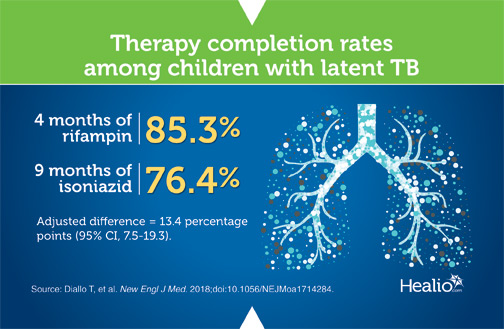Children with latent TB adhere to rifampin better than isoniazid
Although 4 months of treatment with rifampin has comparable safety and efficacy to 9 months of isoniazid for the treatment of latent Mycobacterium tuberculosis infection in children, adherence to treatment was greater among those who were administered rifampin.
“The currently recommended standard treatment for latent tuberculosis infection is isoniazid — a regimen that is considered to be safe in children — for 6 or 9 months, with the longer duration showing greater protective efficacy,” Thierno Diallo, MD, from the Hôpital National Ignace Deen, Université Gamal Abdel Nasser de Conakry, Guinea, and colleagues wrote in The New England Journal of Medicine. “However, both regimens of isoniazid have been limited by poor adherence rates. In adults, 4 months of treatment with rifampin has been shown to be safer and to have better adherence rates than 9 months of treatment with isoniazid.”
The researchers compared the two regimens in children aged younger than 18 years with latent TB infection by conducting a multicenter, open-label trial. Patients received either 4 months of rifampin or 9 months of isoniazid.
Therapy was completed by 85.3% of children receiving rifampin (n = 360 of 422) and 76.4% of children receiving isoniazid (n = 311 of 407; adjusted difference in rates of treatment completion, 13.4 percentage points; 95% CI, 7.5-19.3). The researchers did not observe a significant difference in the rates of adverse events between the two groups, with grade 1 or 2 adverse events possibly related to the trial drug observed in fewer than 5% of children.
Two children were diagnosed with active TB who were treated with isoniazid during 542 person-years of follow-up, with one of these cases demonstrating resistance to isoniazid. No cases of active TB were observed in the rifampin group during 562 person-years of follow-up (rate difference, –0.37 cases over 100 person-years; 95% CI, –0.88 to 0.14).
“Although the only cases of active tuberculosis were diagnosed in the isoniazid group, we cannot conclude that 4 months of rifampin was either superior or noninferior to 9 months of isoniazid for the prevention of active tuberculosis,” Diallo and colleagues wrote. “However, since there were no cases of active tuberculosis in the rifampin group in our trial or among 434 children who received 3 months of once-weekly isoniazid plus rifapentine in another trial, we suggest that these shorter rifamycin-containing regimens are effective.”
The researchers noted that the efficacy of 4-month treatment using rifampin in children is further supported by the results published in a companion trial that assessed treatment in adults. – by Katherine Bortz
References:
Diallo T, et al. New Engl J Med. 2018;doi:10.1056/NEJMoa1714284.
Menzies D, et al. New Engl J Med. 2018;doi:10.1056/NEJMoa1714283.
Disclosures: The authors report no relevant financial disclosures.

